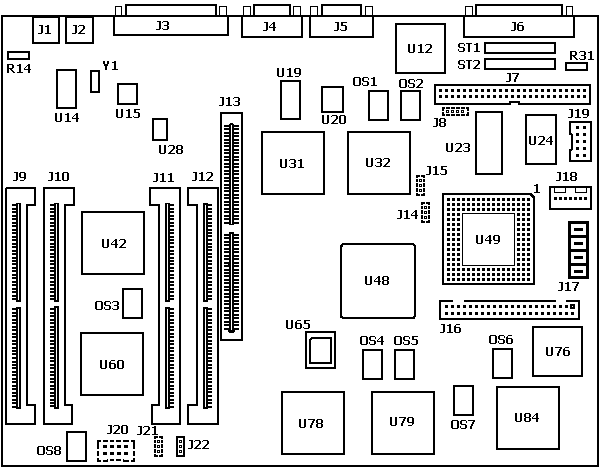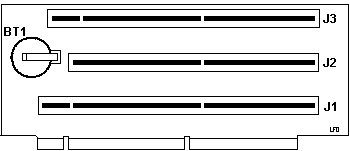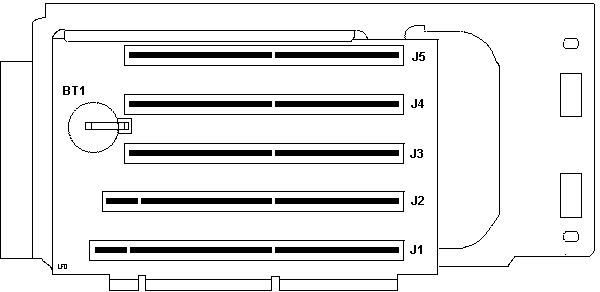|
Reference and Diagnostic Disks
Refdisk and Diags 7677ref.exe 76/77 Reference Diskette Version 3.10 7677diag.exe 76/77 Diagnostics Diskette Bermuda Planar 
U76 This can be either the N82077AA (used on the 90 and 95) or it can be the National Semiconductor PC8477AV-2 floppy controller. A few systems have the 82077SL controller, PLUS U65 System EPROM 39G3299 is soldered directly to the planar (no PLCC socket needed) From Peter
Remind that there were several "Bermuda" boards:
Bermuda vs. Lacuna Riser Card If you think you can just drop a Lacuna into a Bermuda system, you are wrong. The riser cards have physically different edge contacts. Note the edge connectors. The 76i bus adapter support (individual FRU) is 61G2289. This FRU is for the bracket alone. Bermuda Riser
FRU 87F4833
Note the "BVE" like connector at the left (rear) of the riser. As Bermudas do not have on-board video, the riser needs a BVE slot. This riser has the spring clips just like the Lacuna riser. Bermuda 77 Riser FRU 87F4836
The seperate riser card (riveted onto bracket) is FRU 87F4836.
My HMM has the bracket/riser as FRU 87F4836. The bracket/riser is marked
with a sticker as P/N 39G2063
Onboard SCSI From Peter The onboard SCSI of the 95xx is often refered as "Spock-Prime" - and is (almost) identical to the later SCSI with cache ... with the exception of the cache, which it hasn't got. From the design it is *very* similar to the short SCSI without cache, which has an 80C188-16 as well. The SCSI microcode however is part of the machine BIOS stored in a single small 16-bit PLCC Eprom if I remember correctly. There is a part of the SCSI code also included in the IML. This adapter can be found on the 9556/9557, the "Bermuda" 9576/9577 - and the "small" 9585-0Xx. The earlier PS/2 85xx use an onboard version of the old, long SCSI adapter without cache - like the 8556/8557 and 8573-161 and -401 (P75). If you look closely at the 9577 planar you will find some SMD transistor "of the bigger kind" and some stuff that looks like "auto-termination". In addition the onboard SCSI adapter of the "Spock-Prime" is described as "SCSI-2 compliant" ... which extends on the command set in the first place, the enhanced SCSI translation and on the electric interface as well I think. But not on the speed of course, which is 5 MB/s SCSI-1 standard. From IBM
Supports SCSI Common Command Set Version 4.B
(SCSI-2 Compliant)
Bermuda Overclock From Peter Wendt I tried the oscillator swap (Ed. OS5 upped to 80.000 MHz) on a "Bermuda" - with less success so far. The system tries to come up but lands in a number of errors, from which the "trivial ones" (162/163/161) are logically a symptom of the board removal and a total loss of CMOS contents. But the machine comes up with a I9990021 - even with a proper ref-disk in A: ... chokes on reading any other floppy. Guess it is the same problem as with the Mod. 90/95. I tried running the machine with a DX4-33/100 in 2x mode (jumper on interposer), which is known to even work at 50MHz input clock. No go. The cursor in the phase before memory count seems to blink a bit faster ... but then the machine hangs with I999-error after the count. Configuring it properly and *then* swapping the oscillator (which is a bit tricky) did not work either - ran into a solid I999 0022 (invalid IML). Restoring system partition from diskettes also failed. Conclusion: overclocking isn't a good idea. At least not with this (too). Any other experiences ? Upgrading planars You can upgrade any current PS/2 76/77 or PS/2 56/57 with the new PS/2 Planar Upgrade. You'll gain all the advantages of the new 76/77 i and s systems. Current 76/77 systems will perform up to 38% faster while keeping everything else intact. Devil's in the
Details
There are two broad classes of box designs that led to
the 9576 and 9577.
Taller box:
Of course, the 855X were 80386DX or 80386SLC, so they used a completely different system board. The 9576 and 9577 used the same system board (=Bermuda), one with SCSI built into the board (=Bermuda). The 9576i and 9577i (Lacuna system board) were made in two different clock speeds -- 25MHz and 33MHz. Their system board FRU part numbers were: 25MHz only: 95G9691 (not streaming transfer
capable)
A 957Xs is only a 957Xi with a modified Future Domain SCSI
card added to one of the adapter slots on the bus riser card, to handle
internal/external SCSI devices.
Parts Comparison:
9576 Bus adapter*
87F4833
9556 Bus adapter*
79F7210
8556 Bus adapter*
79F7210
9577i/s 5-slot bus riser assembly
68G2709
9577 Bus adapter riser
card 87F4836
9557 Bus adapter riser
card 41G3877
8557 Bus adapter riser
type 1 85F0056
So you see, it is important to know both the part number and clock speed limitation of the Lacuna-type board, and to have the correct bus riser card for the particular box/system board. In other words, you cannot really upgrade a 957X to a 957Xi/s without changing the riser card as well as the system board! HELP!
IBM 76 Security Cable Cover . Hmm, never seen one. 76 / 77 Control
Module Header Pinout
Video Bermuda BVE Slot On the 9576, Slot #1 is the BVE Slot, Slot #3 is the AVE slot. ECP Support
From Peter
That should fix the problem. The 9577 -as most PS/2- has
a "DMA-arbitrated" LPT-port, which is neither ECP nor EPP, only "sort of".
The "Disable" directs the machine not to use DMA during bi-directional
transfers and use a contigous data-stream.
Direct Connection
under W95
Bermuda Planar ADF Serial Port One: Choices are Serial 1 through Serial 16, or disabled. Standard interrupt levels are IRQ 4 for serial 1 and IRQ 3 for any other serial level. Serial Port Two: Choices are Serial 1 through Serial 16, or disabled. Standard interrupt levels are IRQ 4 for serial 1 and IRQ 3 for any other serial level. Parallel Port: Choices are Parallel
1 through 4 or the port can be disabled.
PARALLEL 1 io 03bch-03bfh 1278h-127bh int 7
Parallel Port DMA Arbitration Levels:
Choices are Shared Level 7 through Shared Level 0, (dedicated) Level 7
through (dedicated Level 0), and Disabled.
SCSI Address (ID): ID of the built-in SCSI controller. Choices are ID7 through ID0. Under normal circumstances, select <7>. SCSI I/O Address: Select: I/O address
of the built-in SCSI controller.
SCSI Fairness On/Off: Choices are On or Off. Bus Arbitration Fairness controls whether the adapter will release control of the bus when it has been using it exclusively. Under normal circumstances, select <On>. SCSI DMA Arbitration Level: Choices are Level 1, 3, 5 through E. Selecting an arbitration level allows only this device to use the value. ADP Fields (System determined)
Current System Speed: Current speed of the system, 25MHz or 33MHz. System Board: System board type
CPU Upgrades DX4100-ODPR laburnam@my-deja.com
|


